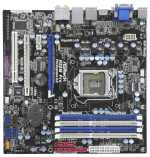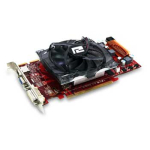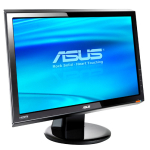System Buyers' Guide: PCs for Under $1000
by Sean Hollister on February 12, 2010 2:00 AM EST- Posted in
- Guides
Intel Mainstream PC
If you have a bit more to spend, the next step up the pricing ladder brings a lot to the table: the Intel Core i3-530, a best-in-class H55 motherboard, a 1080p LCD monitor and a bang-for-the-buck GPU to power it. Now we're talking.
| Intel Mainstream System | ||
| Hardware | Component | Price |
| Processor | Intel Core i3-530 (2.93GHz x2, 32nm, 4MB L3 Cache) |
$120 |
| Cooling | CPU Retail HSF | $0 |
| Video | PowerColor Radeon HD 4850 512MB | $100 |
| Motherboard | ASRock H55M Pro LGA1156 Micro ATX | $95 |
| Memory | G.Skill Ripjaws 4GB DDR3-1600 F3-12800CL9D-4GBRL | $105 |
| Hard Drive | WD Caviar Blue 500GB WD5000AAKS | $54 |
| Optical Drive | Sony Optiarc Model AD-7240S-OB 24X DVDRW SATA | $28 |
| Audio | Onboard | $0 |
| Case | Cooler Master Centurion 5 CAC-T05-UW Mid Tower ATX | $55 |
| Power Supply | OCZ ModXStream Pro 500W ATX12V SLI Certified, CrossFire Ready, 80 PLUS Certified Modular Active PFC (before $25 Rebate) | $65 |
| Base System Total | $622 | |
| Display | ASUS VH226H Black 21.5" 2ms(GTG) HDMI Widescreen 16:9 LCD (1920x1080) (before $20 Rebate) | $170 |
| Speakers | Cyber Acoustics CA-3090 26W 2.1 Speakers | $21 |
| Input | Microsoft B2L-00045 Comfort Curve Black USB Keyboard and Optical USB Mouse - OEM | $22 |
| Operating System | Microsoft Windows 7 Home Premium OEM 1-Pack (for System Builders) | $105 |
| Complete System Bottom Line | $940 | |
| Plus Estimated Shipping (within Continental U.S.) | $990 | |
| Rebates | -$45 | |
| Bottom Line (less tax, if applicable) | $945 | |
Though its price and associated requirements (LGA1156, DDR3) make it prohibitively expensive for entry-level rigs, we fully expect the Core i3-530 to be the starting point for bang-for-the-buck PC building guides around the globe anyhow. That's because at only $125, the Core i3-530 is not only the fastest dual-core processor available today, but also—with two logical threads per core—performs on par with the best budget quad-cores in most benchmarks. If that weren't enough, it features an on-die integrated graphics solution that rivals the best IGPs AMD has to offer (which isn't saying much, sadly) and it does it all while consuming less power than practically any other mainstream CPU out there. And thanks to its 32nm process and a 22x multiplier, it also overclocks to 4GHz using the stock cooler (YMMV).
 |
Paired with this Clarksdale wunderkind is the ASRock H55M Pro, the best, least-finicky H55 motherboard we've yet tested. Featuring the onboard VGA, DVI and HDMI video-out connectors and Flexible Display Interface needed to make use of the Core i3's Intel HD IGP, the board also features a superb layout. It has a pair of PCIe x16 slots (one at x16, one at x4), a PCIe x1 and a PCI slot arranged in a configuration where none of its ports are liable to be covered by expansion cards. Speaking of ports, the board comes with five neatly arranged SATA 3GB/s ports on the board and three USB 2.0 headers, with an eSATA, six USB2.0 ports, a combo PS/2, a single 1394a and optical S/PDIF out on the rear panel. 7.1 channel HD audio duties fall to the VIA VT1718S, while a Realtek 8111DL handles Gigabit Ethernet. There's even a TPM header.
While the board supports all current LGA 1156 Core i7, i5 and i3 processors, up to 16GB of DDR3-2600 memory and even Quad CrossFireX, it's not really a board you'd slot premium DIMMs or multiple GPUs into. We found it to have only moderate overclocking potential, and the PCIe x4 puts the kibosh on even regular CrossFire giving you your money's worth. But for $95, it's a wonderful board on which to build a mainstream PC.
 |
Given the fidelity of the onboard Intel HD Graphics, and assuming you don't care to play modern games in excess of 1024x768 resolution at minimum settings, a dedicated graphics card is honestly quite optional in a Core i3 and H55-equipped mainstream PC. Even without it, you can bitstream Dolby TrueHD and DTS HD-MA over the HDMI connection, handle hardware accelerated decoding of H.264/VC-1/MPEG2 streams, and drive large desktop screens. But because last year's mainstream rig included our editor-favorite Radeon HD 4770, it was hard to pass up the even more powerful, game-crunching $100 Radeon HD 4850. If you'd rather, you can get the slower Radeon HD 5670 for the same price and have access to DX11, Eyefinity and possibly 3D Blu-ray support later this year, or add $40 and get the best of both worlds with the faster Radeon HD 5750 1GB. Alternatively, you can save the $100, or put it towards one of the other goodies in our upgrade list on page 6. But know that when we were looking for a video card with enough value to automatically deserve a place in our mainstream rig, we immediately gravitated towards the 4850.
 |
While all other base components are the same known quantities we used for our entry-level rigs, we upgraded two peripherals for our mainstream PCs that deserve mention here. First, because in-monitor speakers are notorious for their low quality, we bring back last year's Cyber Acoustics CA-3090 2.1 speaker system, a fantastic value even at $20 (compared with $16, nine months ago). Second, we upgraded the LCD monitor to the ASUS VH226H. At $150 after rebate, the VH226H offers far more than $30 worth of extra value over the $120 VW193TR it replaces: it's a 21.5", 1920x1080 TN panel with a 2ms grey-to-grey response time, 1000:1 typical contrast ratio, and the all-important HDMI 1.3 input jack alongside standard DVI and VGA.










86 Comments
View All Comments
DominionSeraph - Saturday, February 13, 2010 - link
For only $6900 + a measly $400 tax (CT), you could have an 8 core 2.93GHz with a whopping 6GB RAM and a rebranded Geforce 8600 GT!Can i haz tek job nao?
chrnochime - Saturday, February 13, 2010 - link
I haven't been keeping up to date with the socket h burn issue. So, has Anand et al figured out, with or without help from the manu, determine the source of the socket burn problem?I can only speak for myself that unless this is determined conclusively, I'm stuck going with either socket 1366 or frantically scour up the last of the 775 motherboards.
stardude82 - Saturday, February 20, 2010 - link
There was never an really issue with the 1156 Boards. The problem was only with Foxconn sockets used for extreme overclocking above 4 Ghz. If you are really concerned there are lots of boards with the Lotts manufactured sockets.clarkn0va - Saturday, February 13, 2010 - link
Ignoring ACC and the possibility of unlocking one core of the Athlon II X3 435, it's not obvious why one would pay an extra 67% for the Phenom II X3 720, at least not from the information provided in the article.Looking in Bench, these two CPUs trade blows on all the benchmarks and there is no obvious winner. Add to that the possibility of turning the 435 into a quad, and the fact that it's $50 cheaper, according to this article, and I have no idea how SH can recommend the 720 at all, at least not without looking at information beyond what's presented here and in Bench. Please enlighten me if I'm missing the point though.
Great article, Sean. It's always interesting to see what other pros are recommending and why.
http://www.anandtech.com/bench/default.aspx?p=112&...">http://www.anandtech.com/bench/default.aspx?p=112&...
SeanHollister - Sunday, February 14, 2010 - link
You're right on the money, pun intended. In terms of performance per dollar at stock clocks, the Athlon is indeed a much better value for today's software, especially if you manage to unlock the fourth core.That said, there are three things that distinguish the Phenom. First, it's a better (and easier) overclocker. Second, it's the better gaming CPU in all benchmarks I've yet seen. Third and most importantly, it's got a sizable L3 cache—fast becoming an industry standard for CPUs—where the Athlon has none.
In today's software and benchmarks, the L3 cache doesn't offer much of an advantage, just as a dual-core processor wouldn't offer an advantage over a single core a number of years back, but I'm guessing that as just as multithreading takes hold, so will the L3 cache that assists it.
All that said, is a bit of futureproofing and a little extra gaming performance worth $50? To be completely honest, when I first chose the Phenom chip, I was calculating its value at the Newegg price of $105, which I realized at the very last minute was the price for the bare CPU, *without a cooler,* and failed to rethink the value equation when I adjusted the price.
piasabird - Friday, February 12, 2010 - link
http://www.directron.com/clarkdalesys1.html">http://www.directron.com/clarkdalesys1.htmlPart Number:SYS-Clarkdale-System-01Regular price:$419.99On Sale: $399.99
System Components:
Processor: Intel Core i3 530 2.93GHz Clarkdale 32nm Dual Core CPU
Memory: 2GB (1x2GB) DDR3 1066 memory
Motherboard: MSI H55M-E33 Socket 1156 Micro-ATX motherboard with Intel H55 chipset
Video: Integrated
Audio: 8 Channel Audio
Storage: 320GB SATA2 Hard Drive
Optical: 24X DVD-RW Drive
Case: Thermaltake V3 Black Edition mid-tower case with TR2 450W power supply.
jigar - Friday, February 12, 2010 - link
My very first post on Anandtech. before today i hadn't even heard of Anandtech. Found it really impressive (especially the CPU benchmark comparison bit).after reading this article i have decided to build my own base unit (with the help of a pal). my old unit stopped working few days ago (hence the reason me trawling the net).
thing is, the prices quoted are in dollars. do you guys have any idea how much cheaper/expensive they are in UK? i tried shopping on amazon for parts and found out that intel core i3 530 is about £90 (is that reasonable? do you guys know where else i could shop for parts?)
also, i got confused whilst reading the article. do i need to buy two hard drives or just one? you have mentioned WD Caviar blue 500GB on the intel mainstream pc system but in the upgrade section you have said that intel X25-V solid state drive which is only 40GB (£96 on amazon) is essential for a multitasker as it also speeds up basic computing and will cut windows load times by half.
i am actually not a gamer. i just want a system where as mentioned above, the windows load up quickly and where i can use different programs at once (without slowing down the computer - e.g. internet and microsoft word etc).
the other thing you mentioned was Cooling - CPU retail HSF - i searched for it on amazon but nothing came up :(
i also already have a monitor so just need a base unit which is fast and reliable (i am totally fed up with installing windows software every few months).
my original budget was between £200 and £300 but may spend upto £400.
Any help will be really appreciated.
FlyTexas - Friday, February 12, 2010 - link
Welcome to AnandTech, one of the better tech review sites on the web.A quick heads up, most of us here have been doing this awhile and are rather techie, so forgive us when we talk over your head, it is not meant to be rude.
The Heatsink & Fan come with the Retail version of the CPU, you do not buy them separately.
You don't have to buy 2 hard drives, the suggestion for the 40GB Intel drive is just due to the speed of SSDs (Solid State Drives). These drives use flash memory rather than spinning disks, they are fast, but expensive.
As for places to buy, almost everyone here will tell you NewEgg, however they do not sell internationally. Google "newegg uk equivalent" to get some ideas.
jigar - Saturday, February 13, 2010 - link
but if i only get one hard drive with a 40Gb storage (i admit it will be faster and that is what i want) but where would i store all the files?what if i buy two hard drives? one fast solid state 40GB to boot up the computer and the other to store files (i would like the system to work for atleast few years so i probably will need a big enough hard drive) so is it possible to have two hard drives, one to boot up and one to store files?
how big is 40GB, will it be enough for me? i watched avatar and saved it on my desktop (the legend of aang series is alone 15GB). it was my favourite so i downloaded it. but i dont download/save movies so probably something like 250 or 500GB should be enough for me?
since i saved those avatar files, my computer went really slow. it would take minutes (literaly) to take any single action.
can you make a separate list for me please? (using uk part names) there is this website www.pcspecialist.co.uk (may be you can guide me through their prices and parts).
Ratman6161 - Friday, February 12, 2010 - link
Take for example your Intel entry level build at $690.00.Check out this from HP: http://www.shopping.hp.com/webapp/shopping/compute...">http://www.shopping.hp.com/webapp/shopp...ktops/Ev...
Or I'll save you the time of following the link by saying its an i3 based system with 4gb DDR3 RAM and onboard video and audio. So that should be better performance than the E5300 and its $549.00
About two months ago I bought my inlaws a similar system but with the 5300 and 3 GB DDR2 on my company's employee purchase program for $349.00.
Build it yourself makes sense for mid-range to high end -- if that is you are the kind of person who wants to get exactly the specs you were looking for. But on the low end, there is just no way that you can build a system for the prices the big OEMs are charging. The other big advantage is that if I built the system for them, then I would also become their technical support where this way they can call HP. Then again, the system has been working so well, they haven't had to call HP either.